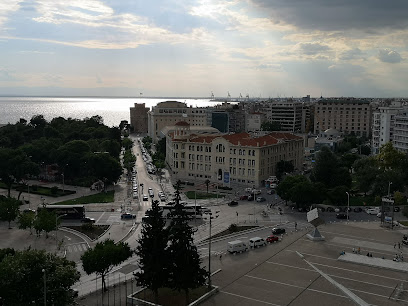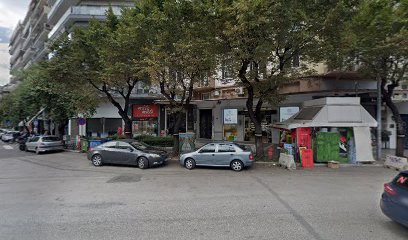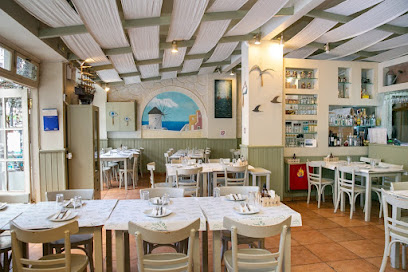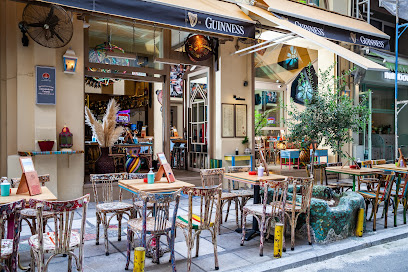
Navarinou Square: The Heartbeat of Thessaloniki
Discover Navarinou Square in Thessaloniki: A vibrant blend of ancient ruins, modern cafes, and eclectic shops in the heart of Greece's historic city.
Navarinou Square is a vibrant and historic neighborhood nestled in the heart of Thessaloniki, Greece. It is a bustling hub that beautifully blends the ancient with the modern, offering tourists a unique glimpse into the city's rich heritage and contemporary culture. The square is surrounded by a mix of ancient ruins, trendy cafes, and eclectic shops, making it an ideal spot for both history buffs and casual strollers. One of the square's most notable features is the Galerius Arch, a Roman triumphal arch that stands as a testament to Thessaloniki's storied past. Just a short walk away, you'll find the Rotunda, another iconic monument that has served various religious purposes over the centuries. These ancient structures provide a stunning backdrop to the square's lively atmosphere, where locals and tourists alike gather to enjoy the area's many attractions. Navarinou Square is also a culinary hotspot, boasting a wide range of dining options that cater to all tastes. From traditional Greek tavernas to contemporary eateries, the neighborhood offers a delectable array of dishes that showcase the region's culinary heritage. Street performers and local artists often add to the square's vibrant ambiance, making it a lively and engaging place to explore. Whether you're interested in delving into the history of Thessaloniki or simply looking for a lively spot to relax and people-watch, Navarinou Square offers something for everyone. Its central location makes it an easy stop on any itinerary, and its unique blend of old and new ensures that visitors will leave with lasting memories.
Local tips in Navarinou Square
- Visit early in the morning or late in the afternoon to avoid the crowds and enjoy a more relaxed atmosphere.
- Don't miss the street performers and local artists who often perform in the square, adding to its lively ambiance.
- Explore the nearby Rotunda and Galerius Arch for a deeper understanding of the area's rich history.
- Try the local delicacies at the various cafes and restaurants around the square for an authentic taste of Thessaloniki.
- Wear comfortable shoes as the area is best explored on foot, with many attractions within walking distance.
Navarinou Square: The Heartbeat of Thessaloniki
Navarinou Square is a vibrant and historic neighborhood nestled in the heart of Thessaloniki, Greece. It is a bustling hub that beautifully blends the ancient with the modern, offering tourists a unique glimpse into the city's rich heritage and contemporary culture. The square is surrounded by a mix of ancient ruins, trendy cafes, and eclectic shops, making it an ideal spot for both history buffs and casual strollers. One of the square's most notable features is the Galerius Arch, a Roman triumphal arch that stands as a testament to Thessaloniki's storied past. Just a short walk away, you'll find the Rotunda, another iconic monument that has served various religious purposes over the centuries. These ancient structures provide a stunning backdrop to the square's lively atmosphere, where locals and tourists alike gather to enjoy the area's many attractions. Navarinou Square is also a culinary hotspot, boasting a wide range of dining options that cater to all tastes. From traditional Greek tavernas to contemporary eateries, the neighborhood offers a delectable array of dishes that showcase the region's culinary heritage. Street performers and local artists often add to the square's vibrant ambiance, making it a lively and engaging place to explore. Whether you're interested in delving into the history of Thessaloniki or simply looking for a lively spot to relax and people-watch, Navarinou Square offers something for everyone. Its central location makes it an easy stop on any itinerary, and its unique blend of old and new ensures that visitors will leave with lasting memories.
Iconic landmarks you can’t miss
Aristotelous Square
Discover the charm of Aristotelous Square in Thessaloniki, a historical landmark bursting with culture, beautiful architecture, and vibrant local life.

Statue of Eleftherios Venizelos
Explore Thessaloniki's rich history at the Statue of Eleftherios Venizelos, a monumental tribute to Greek democracy and heritage.

Ancient Agora Square
Discover the historical essence of Thessaloniki at Ancient Agora Square, where ancient ruins blend with vibrant local culture.

Navarinou Square
Experience the charm and cultural richness of Navarinou Square, a historical landmark in Thessaloniki that captivates tourists with its vibrant atmosphere.

Palace of Galerius
Explore the Palace of Galerius in Thessaloniki, a stunning historical landmark revealing the grandeur of the Roman Empire through its intricate architecture and rich history.

Emilianos Lazaridis Monument
Explore the Emilianos Lazaridis Monument in Thessaloniki, a beautiful historical landmark celebrating Greece's rich cultural heritage.

East Byzantine Walls of Thessaloniki
Discover the East Byzantine Walls of Thessaloniki, an iconic historical landmark that showcases the city's rich heritage and provides breathtaking views.

Aristotle Square Clock
Discover the iconic Aristotle Square Clock in Thessaloniki, a vibrant hub blending history, culture, and local life in Greece's second-largest city.

Basilica of the Galerian Complex
Discover the grandeur of the Basilica of the Galerian Complex, a historical landmark in Thessaloniki, showcasing stunning architecture and rich cultural heritage.

Μέγαρο Πρεβεδουράκη
Discover the historical charm of Preveza in Thessaloniki, a landmark that beautifully embodies Greece's rich cultural heritage and architectural splendor.

Unmissable attractions to see
The Umbrellas Sculpture by Zongolopoulos
Explore the captivating Umbrellas Sculpture in Thessaloniki, a stunning blend of art and nature along the Aegean waterfront.

White Tower Museum
Explore the White Tower Museum in Thessaloniki and uncover the rich tapestry of the city's history through captivating exhibits and stunning views.

Navarinou Square
Explore the enchanting Navarinou Square in Thessaloniki, a lively historical landmark blending culture, cuisine, and community ambiance.

OTE Tower
Discover breathtaking views of Thessaloniki from the iconic OTE Tower, a must-visit attraction for every traveler seeking stunning panoramas.

Το συντριβάνι στον κήπο
Explore the Tsimiski Garden in Thessaloniki – a serene urban oasis perfect for relaxation and cultural experiences amidst the city's vibrant life.

Essential places to dine
Kitchen Bar
Experience delectable Mediterranean cuisine with stunning waterfront views at Kitchen Bar in Thessaloniki.

NAVONA Day & Night
Experience authentic Italian cuisine at NAVONA Day & Night in Thessaloniki - where every meal is a celebration of flavor and tradition.

The Rouga
Discover authentic Greek flavors at The Rouga in Thessaloniki, where Mediterranean cuisine meets warm hospitality.

The Greek
Discover the essence of Mediterranean flavors at The Greek in Thessaloniki - where authentic cuisine meets exceptional hospitality.

Loupino
Experience modern Greek cuisine at Loupino in Thessaloniki – where tradition meets innovation in every delicious dish.

Ouzerie Lola
Discover Ouzerie Lola in Thessaloniki - A Culinary Delight Offering Exquisite Small Plates and Authentic Greek Flavors.

LOCAL Thessaloniki
Discover LOCAL Thessaloniki: A delightful blend of culinary artistry and vibrant atmosphere in Greece's cultural gem.

MAREA sea spirit
Experience luxury dining at MAREA Sea Spirit - where fresh oysters meet exquisite wines in Thessaloniki's vibrant culinary scene.

MONO Unique Fresh (Aristotelous)
Discover Mediterranean delights at MONO Unique Fresh in Thessaloniki - perfect for breakfast lovers seeking authentic flavors.

Mpakalikon
Experience authentic Greek cuisine at Mpakalikon in Thessaloniki – where every meal tells a story of tradition and flavor.

Markets, malls and hidden boutiques
Underground Shop
Explore Thessaloniki's Underground Shop for top-notch sporting goods and a vibrant community atmosphere, perfect for active tourists and locals alike.

I Love Thessaloniki
Discover unique souvenirs that capture the spirit of Thessaloniki at I Love Thessaloniki, your local treasure trove for authentic gifts.

NU MODERN GREEK
Explore NU MODERN GREEK in Thessaloniki for unique souvenirs and locally crafted treasures that embody the spirit of Greece.

REZERVA
Discover unique gifts and authentic Greek souvenirs at REZERVA, Thessaloniki's charming gift shop that showcases local artistry.

GRIGIO
Explore Grigio in Thessaloniki for a stylish selection of women's clothing that combines contemporary fashion with personalized service.

Ostia Boutique
Discover the latest trends in women's fashion at Ostia Boutique in Thessaloniki, where style meets elegance in a unique shopping experience.

eFantasy.gr Boutique
Discover unique gifts and trendy fashion at eFantasy.gr Boutique in Thessaloniki, where quirky meets chic.

Me Unique
Explore Thessaloniki's vibrant fashion scene at Me Unique, where stylish accessories await to enhance your wardrobe.

Brand Stories Thessaloniki-Second Hand Boutique(buy-sell-trade)
Explore sustainable fashion and unique finds at Brand Stories Thessaloniki - a charming second-hand boutique in the heart of Greece.

Onarion - The Greek Concept Store
Explore Onarion in Thessaloniki for unique gifts, handcrafted jewelry, and local souvenirs that embody the spirit of Greek culture.

Essential bars & hidden hideouts
Pulp
Experience the vibrant atmosphere and creative cocktails at Pulp, a must-visit bar in the heart of Thessaloniki, Greece.

Ενοχές Bar
Discover the vibrant atmosphere of Ενοχές Bar, where art meets entertainment in the heart of Thessaloniki's nightlife.

Vogatsikou 3
Experience the vibrant nightlife of Thessaloniki at Vogatsikou 3, a cocktail bar where mixology meets ambiance for an unforgettable night out.

On The Road
Experience the heart of Thessaloniki at On The Road, where great drinks meet stunning waterfront views in a vibrant bar atmosphere.

Wonderwall Fun Bar
Discover the vibrant nightlife of Thessaloniki at Wonderwall Fun Bar, where great music and drinks await you in a lively atmosphere.

Υφήλιος Bar Nationale
Explore the vibrant atmosphere and exquisite drinks at Υφήλιος Bar Nationale, a must-visit destination in Thessaloniki's nightlife scene.

Tenoro
Discover Tenoro, a vibrant bar in Thessaloniki offering an inviting atmosphere, local drinks, and a taste of the city's nightlife.

Funky Monkey SKG
Experience the vibrant nightlife of Thessaloniki at Funky Monkey SKG, where creative cocktails and a lively atmosphere await.

Bolivar
Discover Bolivar, a vibrant bar in Thessaloniki, where local culture meets refreshing drinks and a lively social scene.

Alea Winebar
Discover the vibrant heart of Thessaloniki at Alea Winebar, where exceptional wines and a cozy atmosphere create unforgettable moments.

Local Phrases
-
- HelloΓεια σας
[Ya sas] - GoodbyeΑντίο
[Adio] - YesΝαι
[Ne] - NoΌχι
[Ohi] - Please/You're welcomeΠαρακαλώ
[Parakalo] - Thank youΕυχαριστώ
[Efharisto] - Excuse me/SorryΣυγγνώμη
[Signomi] - How are you?Πώς είστε;
[Pos iste?] - Fine. And you?Καλά. Εσείς;
[Kala. Esis?] - Do you speak English?Μιλάτε αγγλικά;
[Milate anglika?] - I don't understandΔεν καταλαβαίνω
[Den katalaveno]
- HelloΓεια σας
-
- I'd like to see the menu, pleaseΘα ήθελα να δω το μενού, παρακαλώ
[Tha ithela na do to menu, parakalo] - I don't eat meatΔεν τρώω κρέας
[Den troo kreas] - Cheers!ΥΓΕΙΑ!
[Yia] - I would like to pay, pleaseΘα ήθελα να πληρώσω, παρακαλώ
[Tha ithela na plirosso, parakalo]
- I'd like to see the menu, pleaseΘα ήθελα να δω το μενού, παρακαλώ
-
- Help!Βοήθεια!
[Voithia!] - Go away!Φύγε!
[Fiye!] - Call the Police!Καλέστε την Αστυνομία!
[Kaleste tin Astinomia!] - Call a doctor!Καλέστε έναν γιατρό!
[Kaleste enan yatro!] - I'm lostΈχω χαθεί
[Eho hathi] - I'm illΕίμαι άρρωστος
[Eimai arrostos]
- Help!Βοήθεια!
-
- I'd like to buy...Θα ήθελα να αγοράσω...
[Tha ithela na agoraso] - I'm just lookingΑπλά κοιτάω
[Apla kito] - How much is it?Πόσο κοστίζει;
[Poso kostizi?] - That's too expensiveΑυτό είναι πολύ ακριβό
[Afto ine poli akribo] - Can you lower the price?Μπορείτε να μειώσετε την τιμή;
[Borite na miosete tin timi?]
- I'd like to buy...Θα ήθελα να αγοράσω...
-
- What time is it?Τι ώρα είναι;
[Ti ora ine?] - It's one o'clockΕίναι μία ώρα
[Ine mia ora] - Half past (10)Μισή (10)
[Misi (deka)] - MorningΠρωί
[Proi] - AfternoonΑπόγευμα
[Apoyevma] - EveningΒράδυ
[Vradi] - YesterdayΧθες
[Hthes] - TodayΣήμερα
[Simera] - TomorrowΑύριο
[Avrio] - 1Ένα
[Ena] - 2Δύο
[Dio] - 3Τρία
[Tria] - 4Τέσσερα
[Tessera] - 5Πέντε
[Pente] - 6Έξι
[Exi] - 7Εφτά
[Efta] - 8Οχτώ
[Ohto] - 9Εννιά
[Enia] - 10Δέκα
[Deka]
- What time is it?Τι ώρα είναι;
-
- Where's a/the...?Πού είναι ένα/το...;
[Pou ine ena/to...?] - What's the address?Ποια είναι η διεύθυνση;
[Pia ine i diefthinsi?] - Can you show me (on the map)?Μπορείτε να μου δείξετε (στο χάρτη);
[Borite na mou dixete (sto charti)?] - When's the next (bus)?Πότε είναι το επόμενο (λεωφορείο);
[Pote ine to epomeno (leoforeio)?] - A ticket (to ....)Ένα εισιτήριο (για το....);
[Ena isitirio (ya to....)?]
- Where's a/the...?Πού είναι ένα/το...;
History of Navarinou Square
-
Navarinou Square, located in the heart of Thessaloniki, has been a significant focal point for the city's social and cultural life since the 19th century. Originally named after the Battle of Navarino (1827), where the combined naval forces of Britain, France, and Russia defeated the Ottoman fleet, the square symbolizes a pivotal moment in the Greek War of Independence and has since been a gathering place for various movements and celebrations.
-
The architecture surrounding Navarinou Square reflects Thessaloniki's diverse cultural heritage. In the late 19th and early 20th centuries, the square became home to numerous neoclassical buildings, which were representative of the city's burgeoning identity during its transition from Ottoman to Greek rule. These structures continue to influence the aesthetic character of the area, showcasing the blend of styles that define Thessaloniki.
-
Throughout the 20th century, Navarinou Square evolved into a vibrant cultural hub. The square hosted numerous festivals, concerts, and public events, attracting locals and tourists alike. Its proximity to universities and cultural institutions has made it a natural meeting place for students and artists, contributing to Thessaloniki's reputation as a center of intellectual and artistic activity in Greece.
-
Navarinou Square has played a crucial role in various social and political movements in Thessaloniki. From student protests in the 1960s to recent demonstrations advocating for social justice, the square has been a stage for voices demanding change. The historical significance of these events is intertwined with the square’s identity, marking it as a site of resilience and community solidarity.
-
In recent years, Navarinou Square has undergone a transformation aimed at enhancing public space and accessibility. The area has seen the introduction of green spaces, pedestrian pathways, and open-air cafes, making it a lively spot for leisure and relaxation. This revitalization reflects the city's commitment to preserving its history while adapting to contemporary urban needs, solidifying Navarinou Square's role as a central feature of Thessaloniki's urban landscape.
Navarinou Square Essentials
-
Navarinou Square is conveniently located in the heart of Thessaloniki. From the Thessaloniki International Airport (SKG), you can take a taxi or use the public transport network, including bus line 78, which connects the airport to the city center. If you are coming from other neighborhoods, the square is easily reachable by foot, tram, or bus, with several stops nearby, including 'Navarinou' for direct access.
-
Navarinou Square is a pedestrian-friendly area, making it easy to explore on foot. Thessaloniki's public transport system includes buses and trams that connect to various parts of the city. For a more leisurely experience, consider renting a bicycle from one of the local bike-sharing programs. Taxis are also available and can be hailed from the square or booked via local apps.
-
Navarinou Square is generally safe for tourists, but it's advisable to remain vigilant, especially at night. Avoid poorly lit areas and keep an eye on your belongings in crowded spaces. While there are no specific high-crime areas targeting tourists, areas like the outskirts of Ano Poli (Upper Town) can be less safe after dark. Always trust your instincts and exercise caution.
-
In case of an emergency, dial 112 for immediate assistance. Local hospitals and medical facilities are equipped to handle emergencies. It's recommended to have travel insurance that includes medical coverage. For minor health issues, pharmacies in the area are open and well-stocked with over-the-counter medications.
-
Fashion: Do dress appropriately, especially when visiting nearby churches; avoid overly casual or revealing clothing. Religion: Do respect local customs; when entering religious sites, be sure to cover your shoulders and knees. Public Transport: Do give up your seat to the elderly and those in need; don't eat or drink on public transportation. Greetings: Do greet with a friendly 'Kalimera' (Good morning) and a handshake; don't engage in overly familiar behavior with strangers. Eating & Drinking: Do try local specialties such as souvlaki and baklava, and accept food offerings; don't waste food or be overly picky.
-
To experience Navarinou Square like a local, visit the nearby markets for fresh produce and local delicacies. Engage with local vendors and ask for recommendations on where to eat or drink. The square is also a hub for artistic events, so check local listings for concerts or exhibitions. For a unique experience, explore the side streets for hidden cafes and bars that offer authentic Thessaloniki vibes away from the tourist crowds.
Nearby Cities to Navarinou Square
-
Things To Do in Katerini
-
Things To Do in Serres
-
Things To Do in Larissa
-
Things To Do in Kavala
-
Things To Do in Volos
-
Things To Do in Meteora
-
Things To Do in Pogradec
-
Things To Do in Lamia
-
Things To Do in Ioannina
-
Things To Do in Gjilan
-
Things To Do in Delphi
-
Things To Do in Ferizaj
-
Things To Do in Kamenica
-
Things To Do in Alexandroupoli
-
Things To Do in Gjirokastër










